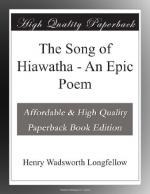|
This section contains 2,228 words (approx. 8 pages at 300 words per page) |

|
SOURCE: “Hiawatha,” in The Feminine Fifties, D. Appleton-Century Co., 1940, pp. 167-76.
In the following essay, Pattee discredits the Native American mythology in The Song of Hiawatha and discusses the many parodies of the poem.
In 1854, Longfellow, aged forty-four, abandoned his lifework of teaching, for which he had so thoroughly prepared himself, to make poetry his sole profession. He would build now that “tower of song with lofty parapet” of which so long he had dreamed. It was “no middle flight” he would take. He would write an American epic with gods and demi-gods on earth among men. And that meant Indians.
Ever since Chateaubriand, the “noble savage” theme had been presented as the one hope for an American literature. After the early “Leather-Stocking Tales,” the North American Review had reopened the subject with Bostonian logic. N. P. Willis had argued that Indian life and Indian legend were our...
|
This section contains 2,228 words (approx. 8 pages at 300 words per page) |

|


